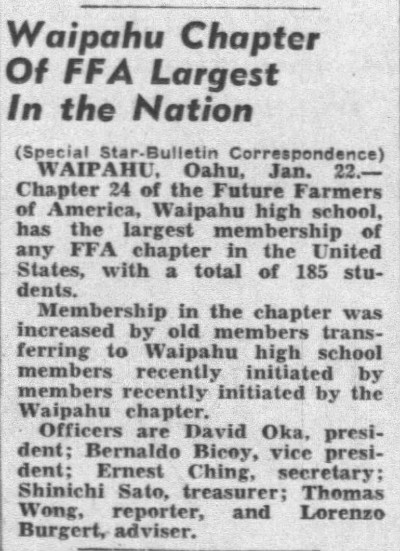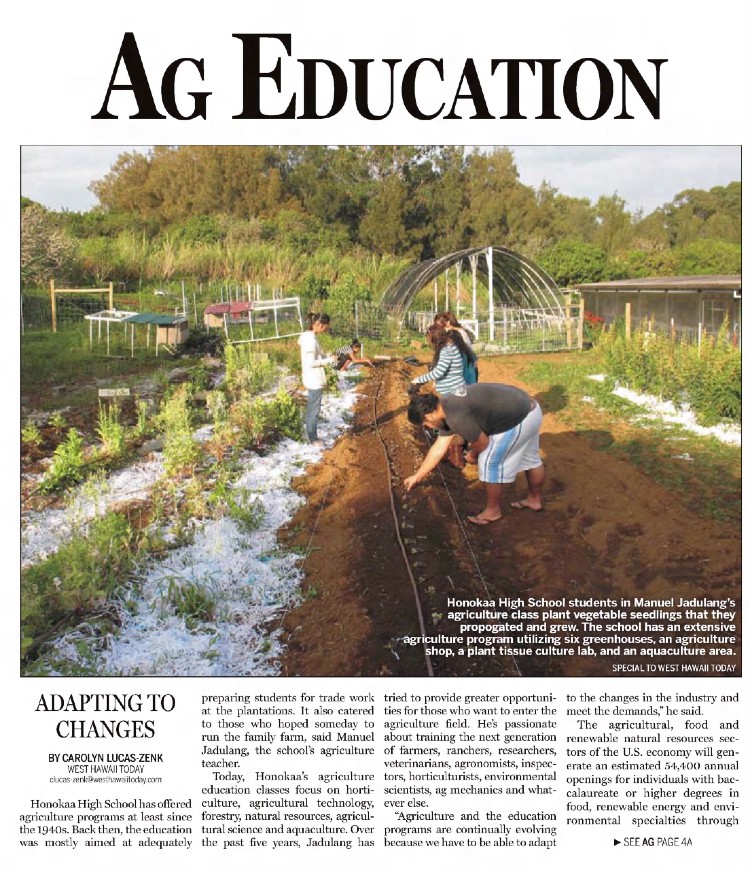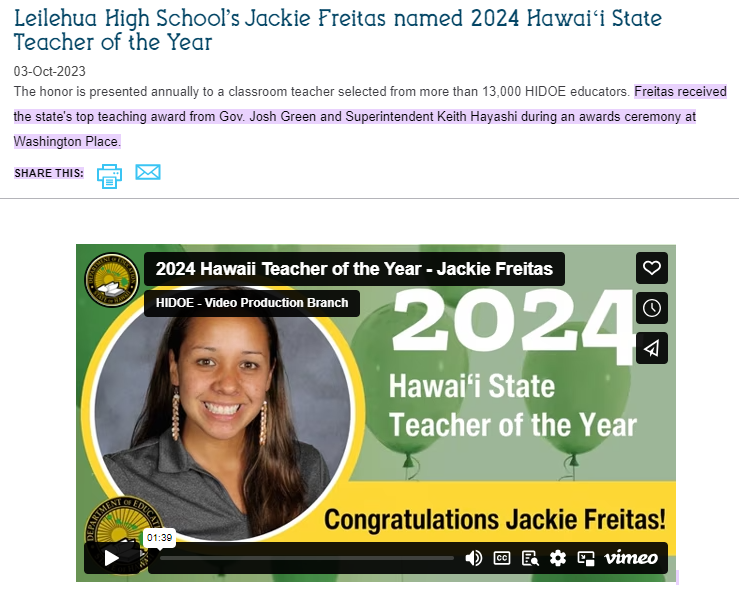The previous two Friday Footnotes (The Impact of Hawaii on American Vocational Education, Raising Cane) examined the early days of agricultural education in Hawaii. This week we will continue our journey by starting in 1928 and ending in 2024. Let the journey begin.
More Than Chicken Feed!
How does an agricultural education program get into the poultry business? According to Frank Kinnison, the agriculture teacher at Hilo High School, you build a chicken house and then have each student bring five to ten hens from home to place in the chicken house, but each boy retains ownership of his hens. The profit from the egg selling enterprise is returned to the boys depending upon how many eggs his hens lay. For details about this vo-ag poultry enterprise see Figure 1.

Figure 1. Hawaii Tribune-Herald, November 23, 1928,
Who Would Have Thought It!
During the past several decades there has been some friendly rivalry among schools to see who has the largest FFA chapter in the United States. If I were preparing a multiple choice quiz on which school had the largest FFA chapter in 1940 and listed a school in Hawaii, I doubt if anyone would choose that as an answer. But in 1940 the Waipahu FFA Chapter in Hawaii with a membership of 185 students was recognized as the largest FFA chapter in the nation. See Figure 2.

Figure 2. Honolulu Star-Bulletin, January 23, 1940
Don’t Bet on It!!
In 1947 legislation was introduced in Hawaii to legalize pari-mutuel betting. At a public hearing one witness testified that 4-H and FFA in California had approved of pari-mutuel betting. The implied message was that 4-H and FFA in Hawaii was also for it.
The Honolulu Star-Bulletin contacted the state leaders of 4-H and FFA in California to get the facts. The replies from the California leaders were blunt.
- B. H. Crocheron, director of agricultural extension in California stated “The 4-H clubs of California have not indorsed pari-mutuel betting and took no part in legalizing it in California.”
- J. McMahon, chief of the agricultural education bureau in California stated, “At no time has any resolution ever been presented to the Future Farmers of America asking them to endorse pari-mutuel wagering. The Future Farmers of America are not engaged in politics and are interested entirely in becoming better farmers and better rural citizens.”
The newspaper transmitted these messages to the chair of the house judiciary committee which was considering the two betting bills. The paper wanted to set the record straight that 4-H and FFA did not endorse pari-mutuel betting.

Figure 3. Front page article Heading from the Honolulu Star-Bulletin, April 18, 1947.
Equity Comes to Hawaii (and the U.S)
In researching material for this Footnote I found a photo of the newly elected territorial FFA officer team with the territorial sweetheart in the middle of the officers. I also found over 100 newspaper articles in Hawaii over the years that reported on chapter or territorial sweethearts. One such article was about Ellen Kapuras, the territorial FFA sweetheart in 1955 (see Figure 4). She danced the hula to successfully beat out the other three candidates.
I was delighted to find an article published in 1970 (See Figure 4) that stated females were now able to be members of the Future Farmers of America. It appears that Frank Kaneda, the agriculture teacher at Hilo High School was responsible for this announcement. Congratulations Frank. I personally know several agriculture teachers who tried to bury this type of information from students and the public after girls were admitted to the FFA. Sad.

Figure 4. The article on the left is from the Hawaii Tribune-Herald, April 15, 1955.
The article on the right is from the Hawaii Tribune-Herald, May 14, 1970. The times are changing.
Adapting to Change
Admitting females to membership in the FFA was one positive change in agricultural education. Another positive change was to modify the curriculum.
In a newspaper interview in 2012 Manuel Jadulang, the agriculture teacher at Honokaa High School, told how the agricultural education curriculum in the 1940s at his school was aimed at preparing students for work on plantations or operating the family farm. Today the curriculum focuses on horticulture, agricultural technology, forestry, natural resources, agricultural science and aquaculture. Mr. Jadulang stated that “we have to be able to adapt to the changes in the industry…” Those words of wisdom apply to all agricultural education programs, not just those in Hawaii. See Figure 5.

Figure 5. West Hawaii Today, Kailua-Kona, Hawaii. February 3, 2012
The Teacher Make a Difference
In 2011 Leilehua High School had 70 students enrolled in agriculture classes. Two years later that number had risen to 180, the maximum the program could handle. A new teacher made the difference with an emphasis on growing food, cooking food, and then enjoying the food. The teacher, Jackie Akuna, not only taught the students how to grow food but also how to cook it. The students quickly discovered some food they thought they didn’t like was actually pretty good. The “grow-cook-enjoy” recipe might be a good way to teach agriculture on the mainland. See Figure 6.

Figure 6. Honolulu Star-Advertiser, February 20, 2013
Let’s fast forward to 2024. Jackie Akuna Freitas, the agriculture teacher at Leilehua High School, was recently named the Hawaii State Teacher of the Year. Please check out the news release and embedded video at this link. Congratulations Jackie. Well deserved. Teachers do make a difference.

Figure 7. Press release from the Hawaii State Department of Education
Concluding Remarks
We have completed our series of Footnotes on agricultural education and FFA in Hawaii. While many people have idolized views of what it must be like to teach agriculture in Hawaii the truth is teachers make a difference and the curriculum has to be up-to-date no matter where you are.
Next Week – “I” is for Idaho
